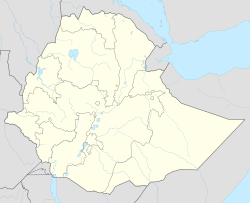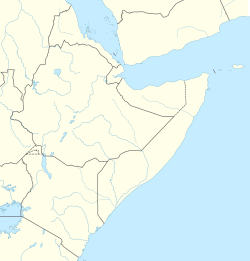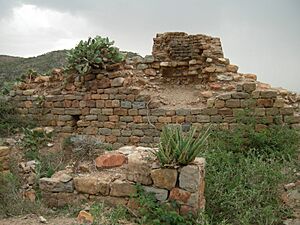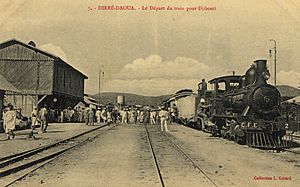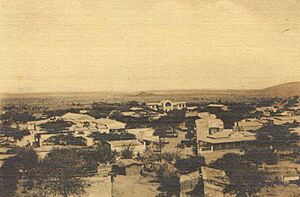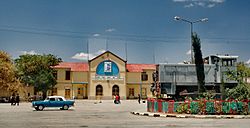Dire Dawa facts for kids
Quick facts for kids
Dire Dawa
|
|||
|---|---|---|---|
|
Chartered city
|
|||
|
From top: Dire Dawa Train Station; Dire Dawa Downtown; Street view of Dire Dawa; Kafira Market; Skyline view in afternoon; Bete Mikael Church
|
|||
|
|||
| Country | |||
| Founded | 24 December 1902 | ||
| Government | |||
| • Type | Chartered city | ||
| Area | |||
| • Chartered city | 1,213 km2 (468 sq mi) | ||
| Elevation | 1,276 m (4,189 ft) | ||
| Population
(July 2019)
|
|||
| • Chartered city | 493,000 | ||
| • Density | 406.4/km2 (1,052.6/sq mi) | ||
| • Urban | 277,000 | ||
| Time zone | UTC+3 (EAT) | ||
| Area code(s) | (+251) 25 | ||
| HDI (2019) | 0.570 medium · 3rd of 11 |
||
| Website | www.dire-dawa.gov.et | ||
Dire Dawa is a major city in eastern Ethiopia. It's located near the borders of the Somali Region and Oromo areas. It's one of only two "chartered cities" in Ethiopia, meaning it has its own special government, much like the capital city, Addis Ababa.
The name Dire Dawa has different meanings in local languages. In Somali, Diridhaba means "where the Somali ancestor Dir hit his spear into the ground." In Amharic and Harari, it means "Plain of Medicine." In Oromo, Dirree Dhawaa means "Place of Remedy."
Dire Dawa is split into two main parts: the city itself and a rural area called Gurgura. The city sits on the Dechatu River and is surrounded by cliffs. It's an important center for industry and trade, with many markets and its own airport, the Dire Dawa Airport.
In 2015, about 440,000 people lived in the whole chartered city. The city part alone had about 277,000 residents, making it the seventh largest city in Ethiopia.
Contents
Dire Dawa's Story
How Dire Dawa Began
The area around Dire Dawa has been home to people for a very long time, even since the Stone Age! Ancient rock paintings and tools have been found in caves nearby. It's also believed that the Harla people, who are now extinct, once lived here.
Long ago, this region was part of the Adal Sultanate. Later, in the 1800s, it was part of the Emirate of Harar. In 1887, it became part of modern Ethiopia.
The City is Born (1902-1936)
The city of Dire Dawa is quite new. It was founded because of a problem with building the Addis Ababa-Djibouti Railway. The mountains near Harar were too steep for the train tracks. So, in 1902, the railway ended at a village at the foot of the mountains. This date, December 24, 1902, is considered the day Dire Dawa was founded.
The railway was very important for Dire Dawa. It helped the city grow quickly, attracting a lot of trade that used to go through Harar. The Ethiopian government even moved its customs office here, showing how important Dire Dawa was becoming for trade with the Red Sea.
Dire Dawa grew into two main parts, separated by the Dechatu River. One part was carefully planned by the railway engineers and was home to railway workers and Europeans who opened shops and hotels. This area had a French feel to it. The other part, around the market, was mainly home to Ethiopian, Somali, and Arab traders.
By the 1920s, the market area also started to grow, mostly with Somali and Oromo residents. The city's population reached about 20,000 people. During this time, two hospitals were built, and schools were opened by the government and different communities. Dire Dawa became a modern city with good roads, electricity, and running water.
Italian Rule (1936-1941)
In May 1936, Italian troops took over Dire Dawa during the Second Italo-Abyssinian War. The Italians built new buildings for their government and improved roads and the airport. They had big plans for the city, but their rule ended before they could finish everything.
During this time, the Italian army entered Ethiopia from both the north and southeast. Dire Dawa was where these two forces met. Even though the city was occupied, some local fighters, called Arbegnoch (Patriots), continued to resist.
After the Occupation (1941-1974)
In March 1941, Allied forces freed Dire Dawa from Italian control. The city continued to grow, and its population reached 160,000. More factories and better services were added.
After the empire was restored in 1941, Dire Dawa was one of the first towns to have its own soccer league. A labor union for railway workers was also formed, focusing on their well-being.
A Time of Change (1974-1991)
The Ethiopian Revolution brought many changes to Dire Dawa. Some factories were taken over by the government. Many foreign residents left the city.
During the Ogaden War in 1977, Somali troops attacked Dire Dawa. The battle was intense, but the Ethiopian air force played a key role in stopping the attack by destroying many Somali tanks. Holding Dire Dawa was a very important victory for Ethiopia in that war.
Dire Dawa Today (1991-Present)
In 1991, the EPRDF forces took control of Dire Dawa. For a few years, different groups claimed the city, leading to some disagreements. To avoid conflict, the federal government decided to make Dire Dawa a special "chartered city" with its own administration in 2004.
In August 2006, Dire Dawa experienced severe flooding when the Dechatu River and Gorro River overflowed. Many people were affected, and homes and markets were damaged. Floods are common during the rainy season from June to September.
Today, there are plans to make Dire Dawa even better. Old parts of the city might be rebuilt with new financial centers, malls, hotels, and hospitals. Historical buildings will be restored, and new roads, parks, and industrial areas are planned. A major railway project is also expected to boost business in the city.
Dire Dawa's Weather
Dire Dawa has a warm climate, usually described as a tropical savanna climate. The average temperature is about 25.9°C (78.6°F). The hottest average temperature is around 32.8°C (91.0°F), and the coolest average is about 19.0°C (66.2°F).
The city has two rainy seasons. A smaller one happens in March and April, and a bigger one from July to August. On average, Dire Dawa gets about 670 mm (26 inches) of rain each year.
| Climate data for Dire Dawa (1991-2020, extremes 1952–present) | |||||||||||||
|---|---|---|---|---|---|---|---|---|---|---|---|---|---|
| Month | Jan | Feb | Mar | Apr | May | Jun | Jul | Aug | Sep | Oct | Nov | Dec | Year |
| Record high °C (°F) | 38.0 (100.4) |
42.0 (107.6) |
42.0 (107.6) |
37.8 (100.0) |
39.9 (103.8) |
39.5 (103.1) |
38.2 (100.8) |
37.3 (99.1) |
37.4 (99.3) |
38.4 (101.1) |
36.4 (97.5) |
36.0 (96.8) |
42.0 (107.6) |
| Mean daily maximum °C (°F) | 29.3 (84.7) |
31.1 (88.0) |
32.8 (91.0) |
33.4 (92.1) |
34.5 (94.1) |
35.6 (96.1) |
33.9 (93.0) |
32.7 (90.9) |
32.2 (90.0) |
33.0 (91.4) |
31.0 (87.8) |
29.4 (84.9) |
32.6 (90.7) |
| Daily mean °C (°F) | 22.2 (72.0) |
23.7 (74.7) |
26.0 (78.8) |
26.8 (80.2) |
28.7 (83.7) |
29.2 (84.6) |
27.5 (81.5) |
26.7 (80.1) |
27.1 (80.8) |
25.9 (78.6) |
23.8 (74.8) |
21.9 (71.4) |
25.8 (78.4) |
| Mean daily minimum °C (°F) | 14.7 (58.5) |
16.4 (61.5) |
18.9 (66.0) |
20.7 (69.3) |
21.8 (71.2) |
22.6 (72.7) |
21.1 (70.0) |
20.6 (69.1) |
20.9 (69.6) |
18.8 (65.8) |
16.2 (61.2) |
14.6 (58.3) |
19.0 (66.2) |
| Record low °C (°F) | 3.0 (37.4) |
6.0 (42.8) |
7.2 (45.0) |
5.0 (41.0) |
10.3 (50.5) |
11.8 (53.2) |
7.3 (45.1) |
6.5 (43.7) |
8.5 (47.3) |
6.0 (42.8) |
7.6 (45.7) |
1.0 (33.8) |
1.0 (33.8) |
| Average rainfall mm (inches) | 15 (0.6) |
27 (1.1) |
74 (2.9) |
113 (4.4) |
78 (3.1) |
42 (1.7) |
115 (4.5) |
158 (6.2) |
105 (4.1) |
36 (1.4) |
16 (0.6) |
13 (0.5) |
792 (31.1) |
| Average rainy days (≥ 0.1 mm) | 2 | 3 | 7 | 10 | 6 | 5 | 11 | 14 | 10 | 3 | 2 | 1 | 74 |
| Average relative humidity (%) | 55 | 56 | 55 | 55 | 47 | 44 | 50 | 53 | 52 | 45 | 49 | 51 | 51 |
| Average dew point °C (°F) | 11 (52) |
12 (54) |
12 (54) |
15 (59) |
15 (59) |
14 (57) |
15 (59) |
16 (61) |
15 (59) |
12 (54) |
12 (54) |
11 (52) |
13 (56) |
| Mean monthly sunshine hours | 294.5 | 265.6 | 257.3 | 246.0 | 244.9 | 204.0 | 220.1 | 244.9 | 234.0 | 248.0 | 282.0 | 300.7 | 3,042 |
| Mean daily sunshine hours | 9.5 | 9.4 | 8.3 | 8.2 | 7.9 | 6.8 | 7.1 | 7.9 | 7.8 | 8.0 | 9.4 | 9.7 | 8.3 |
| Source 1: Météo Climat | |||||||||||||
| Source 2: Deutscher Wetterdienst (humidity 1957-1982 and sun 1994-2012), World Meteorological Organisation (rainfall 1981–2010), Time and Date (dewpoints, 2005-2015) | |||||||||||||
People of Dire Dawa
Ethnic groups of Dire Dawa (2007) Oromo (46%) Somali (24%) Amhara (20%) Gurage (4.5%) Other (5.5%)
Religion in Dire Dawa (2007) Muslim (70.9%) Orthodox (25.6%) P'ent'ay (2.8%) Catholic (0.4%) Traditional faiths (0.1%) Other (0.2%)
In 2007, Dire Dawa had a population of 341,834 people. About 68% of them lived in the city itself. On average, there were about 4.5 people per household.
Many different ethnic groups live in Dire Dawa. The largest groups are the Oromo (46%), Somali (24%), and Amhara (20%). Other groups like the Gurage also live there.
Most people in Dire Dawa are Muslim (70.9%). A significant number are also Ethiopian Orthodox Christians (25.6%). Other Christian groups like Protestants and Catholics also live in the city.
Many people in Dire Dawa have access to safe drinking water. In 2004, almost all urban residents (99.48%) had safe water, and about 69.61% of rural residents did.
Getting Around
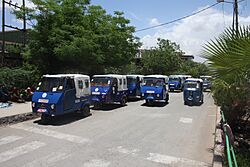
Dire Dawa is an important transportation hub. It has a train station for the Addis Ababa–Djibouti Railway, which connects the city to the capital and Djibouti. The city also has its own airport, the Dire Dawa Airport, offering flights.
For travel between cities, the Selam Bus Line Share Company provides bus services. Inside the city, you'll often see Bajaj vehicles, which are like small taxis.
Learning in Dire Dawa
The Dire Dawa University was established in 2006, providing higher education for students in the city and surrounding areas.
Places to Worship
Dire Dawa is home to many places of worship. There are many mosques for Muslims. For Christians, there are churches belonging to the Ethiopian Orthodox Tewahedo Church, the Ethiopian Evangelical Church Mekane Yesus, the Ethiopian Kale Heywet Church, and the Ethiopian Catholic Archeparchy of Addis Abeba. There is also the Ethiopian Full Gospel Believers' Church.
Dire Dawa in Books
The city of Dire Dawa was the inspiration for a fictional town called "Debra Dowa" in the book Black Mischief by the English author, Evelyn Waugh.
City Leaders
The leaders of Dire Dawa's Administrative Council have included:
- Abebe Eshete: 1981 – 1991
- Habtamu Assefa Wakjira: 1991 – 1993
- Ismail Aw Aden: 1993 – 1995
- Solomon Hailu: 1995 – 2003
- Fisseha Zerihun: 2003 – 2006
- Abdulaziz Mohammed: 7 August 2006 – 2008
- Adem Farah: June 2008 – 2010
- Asad Ziad: June 2010 – 2015
- Ibrahim Uthman: June 2015 – 2021
- Kedir Juhar: 29 September 2021 –present
Famous People from Dire Dawa
- Ali Birra
- Ato Hussein Ismail
- Luciano Violante
- Ismail Omar Guelleh
- Abdul Majid Hussein
- Samia Gutu
Images for kids
See also
 In Spanish: Dire Dawa para niños
In Spanish: Dire Dawa para niños










